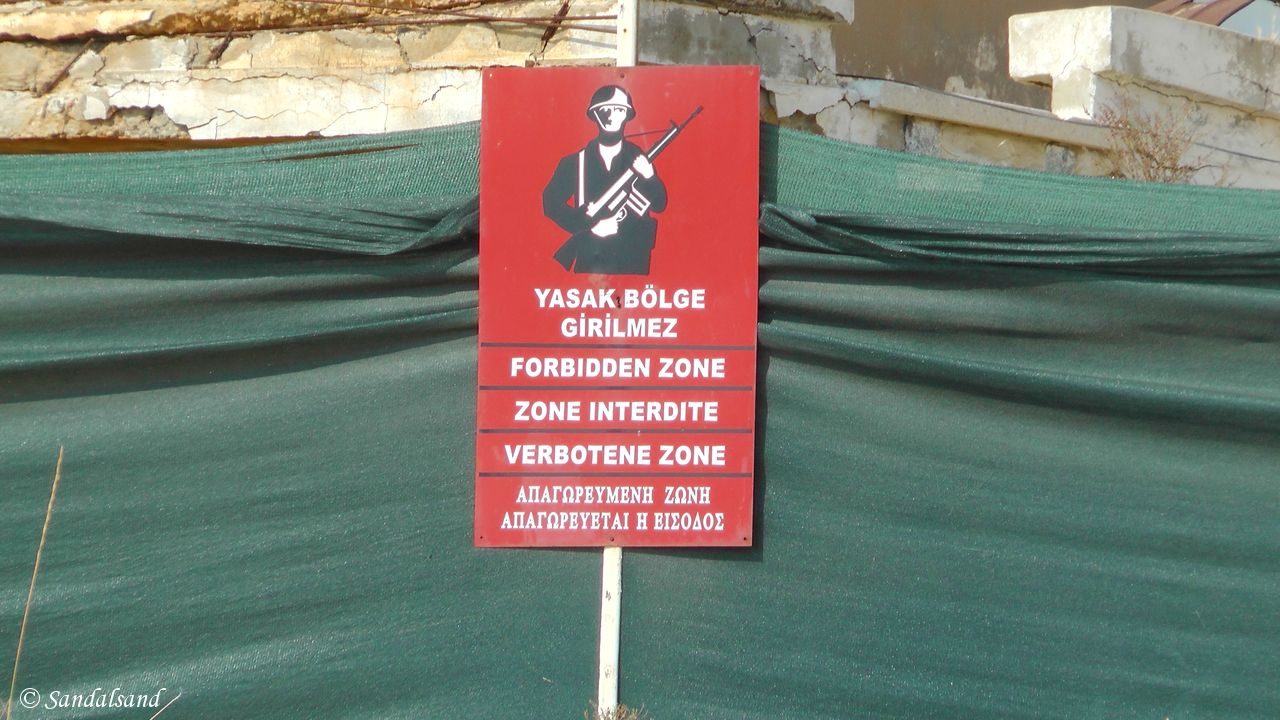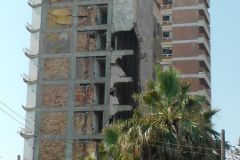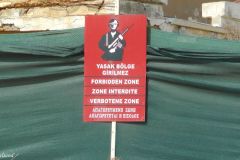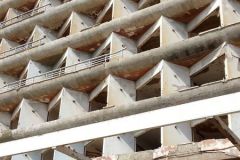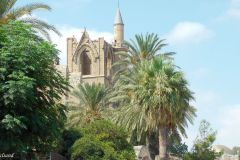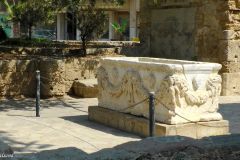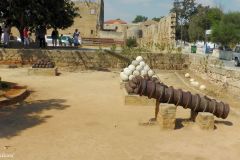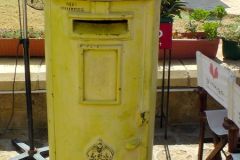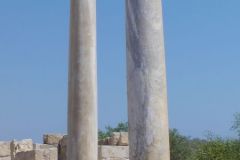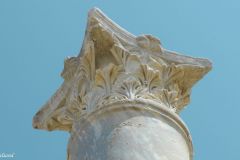We had decided to pay a visit to northern Cyprus. Thanks to the war 40 years ago that objective is not an easy one to accomplish.
We went on a day trip into the north from the southern resort of Ayia Napa, first to Famagusta and Salamis in the east and then to both sides of the divided capital Nicosia in the middle of the island. Nicosia is described in the next chapter.
A short history of modern Cyprus
Cyprus has the apparent misfortune of being strategically located in the eastern Mediterranean. Subsequently the island has been invaded and controlled by a large number of foreign powers for centuries. The latest foreign power to reign Cyprus was Britain (1878-1960).
The war in 1974
Moreover, the island is inhabited by two people groups, Greek-Cypriots and Turkish-Cypriots. The latter have traditionally lived in the north and are Muslim by religion. The Greeks in the south are Greek Orthodox Christians and are more numerous – and more affluent. Language is of course another divisive element. It took only a few years after the formal independence before clashes began. There had been political rivalry all along, but in the years up to the militarily enforced division in 1974 the problems became ever so troublesome to solve peacefully. Or so it seemed.
In Cyprus the NATO allies and traditional foes, Greece and Turkey, fought a war by proxy. The tumbling military junta dictators in Greece needed something to rally support at home, and the military in Turkey were behaving very aggressively as well before finally invading the northern shores of Cyprus.
After a ceasefire had been negotiated, the republic was split into two divided by a so-called “Green Line”, guarded by UN soldiers. The northern side declared independence, but was only recognised by Turkey. The rest of the world community holds the southern part to be the legitimate state power.
Thousands were killed in the inter-communal violence before the invasion, even more as a result of the invasion, and hundreds of thousands were displaced, effectively creating clear ethnic divisions in the country. (20 years later the same thing happened in the Balkans, and another 20 years later in Ukraine.)
After the war
Over the years after the war, there has been much development in the south (in particular tourism) and very little in the north. Crossings of the Green Line were made impossible. The line is not “green” but is in effect a no-man’s land with only a few crossings. The Turkish are particularly fervent in guarding the border but in recent years UN administered talks have led to a gradual ease of tension.
It is now possible with relative ease for all Cypriots and tourists alike to cross the line and return safely. Nicosia is still the only divided capital in the world and the barricades right through the city centre are stunning evidence of mankind’s folly.
Our plan
We only had a week on the beaches of Ayia Napa in the south and had been on a wonderful day-trip into the Troodos mountains. This time we wanted to spend a day in the north, cross the Green Line, and visit both sides of the divided capital.
We found the same bus company as on the previous trip and rented a minibus with a driver. For a group it was not too expensive (300 EUR).
In our early plans we had sketched a visit over the mountain range crossing east to west on the Turkish side, visit a few castles and the pretty harbour town of Kyrenia. We had even pondered the possibility of watching sea-turtles laying eggs on the beaches on the far north-east. We decided to let go of all this. Time was the constraining factor.
Ayia Napa to Famagusta’s Ghost Town
The old town of Famagusta on the eastern coast used to be a popular tourist resort before the war, but now the hotel area outside the old town with its Venetian walls is off limits to all but Turkish soldiers.
Crossing the border
We had started early in the morning and had no problems driving the short hour past a British military base, they still have a couple of them, to the control post on the border. There was in reality only one, on the Turkish side. We offered our passports and a loose sheet of paper on which we had written our names, nationality and passport numbers. In return we were granted a stamp on it.
It was a swift procedure and we were lucky to get ahead of a tour group out of Ayia Napa on one of the numerous half-day trips into Famagusta.
It was clear that our driver had been here before, and not only as a professional driver. He told us that he used to be living in what is now the Turkish side but had to flee after the Turkish invasion to a town south of the border. We understood through him and others that it was still not common practice to visit “the other side”.
Anyway, we soon reached Famagusta and were driven through a part of the city that had been more or less locked down. Huge barbed wire fences had been erected, signs stated that photography was not allowed, and it all looked like the war had ended just a few weeks earlier.
The Ghost town of Varosha
The minibus found a parking space near the sea and we were let out into the area that is called Varosha. To our left there was a nice, operating hotel. To our right there was, behind a huge fence, a bombed out ruin of another hotel. This is what they call the Ghost Town.
In Ayia Napa there are a number of tour agencies pushing tickets to the Ghost Town. They go by boat but none of them land onshore. I am unsure of how close they get, but we had an outspoken wish of getting very close – and we did.
There was a very nice sandy beach straight ahead with a few beach beds and even fewer guests. Behind us to the right there were a string of hotels, all abandoned. Some of them had received direct shell hits, others had just been empty for the last 40 years. There was an eery atmosphere about this place, so beautiful and yet so tense.
Taking photographs?
We started taking photos and film. All of a sudden we heard a whistle blow. At once we did not realise the reason but after a few more blows we noticed that the person on the concrete watchtower at the far end of the beach had started to move out of his position and was staring at us. Photography was prohibited and he was the watchman. One doesn’t argue with Turkish soldiers, so we started our retreat.
A former colleague of one of us had been here during the days of the invasion, on vacation. He had said that they were having breakfast when the town was attacked by the Turkish military. They had to flee as fast as they could. In fact, everything was left as it was, even the food on the table. Three years later a Swedish reporter arrived and reported home: “Today, September 1977, the breakfast tables are still set, the laundry still hanging and the lamps still burning […] Famagusta is a ghost-town”.
Upholding a ban on photography seems quite unnecessary. Just have a look at this Google picture search for Varosha.
Some thoughts
One may wonder why this area is closed, and why there has been no redevelopment of it. I would suppose there are some serious legal issues arising for any company evaluating a redevelopment project here. There are probably many reasons (safety in walking in between all this decay might be one) but in essence it boils down to this simple question: Who owns this real estate? It will probably be too risky to invest here if the property later is handed over to the real owner.
In any case we left Varosha and the beach and went into the old town of Famagusta.
Old Famagusta
This is another story, or maybe not. The fact is that the centre of Famagusta is a great place to visit. It is quite small, there is an almost intact wall erected by the Venetians centuries ago circumfering it, and there are several nice streets and sights within those walls.
We parked at one of the old gates (the Sea Gate) and went into town. One interesting matter of fact is that this northern Cypriot town has received EU funding for restoring the wall from this gate right until the next bastion on the wall. After all, Cyprus is part of the EU, and per definition also the northern side. When it comes to external funding, no politicians can hold on to their principles. In any case, the wall being fixed includes the Othello Tower. Remember Shakespeare?
Famagusta looked like an easygoing town. There were few tourists apart from a busload from the south. There were a couple of pedestrian shopping streets but even the non-pedestrian streets had very little traffic.
A few large churches dominate the horizon of Famagusta’s Old Town. The cathedral of St. Nicholas is the largest, dating back to the 14th century. This Gothic style church has been converted into a mosque and is called the Lala Mustafa Pasha Mosque.
Across the square in front of this church/mosque there are some remains of the ancient days, well worth looking into. Have a look at the cannon balls dating back to the Ottoman siege and conquering in 1570. It is said that 150,000 of them were shot at Famagusta. Some of the cannon balls are iron, others are perfectly shaped round stones.
Ancient Salamis
Just a short drive north of Famagusta we reached the town of Salamis. Once upon a time this ancient Greek city-state was a powerful player in Cyprus and the eastern Mediterranean. Today it is an archaeological site worth looking into.
It was clear that archeologists had been at work here for a long time. One of the ancient amphitheatres was very much alive, workers were being busy setting up a stage when we arrived. The other amphitheatre was only evident by a sign stating where it once stood.
Several marble columns were laying flat on the ground, others had been stood up to indicate how it once was.
Have a look at the baths, see if you can find the last remaining murals and floor tiles. The ancient Greeks would always have a gymnasium in their cities. There is one here as well. Only the columns and floor remain, but it is still a wonderful sight.
Read more
This article is the third of four from Cyprus. All articles:
(1) The easy life on the beaches of Ayia Napa
(2) A day-trip into the Troodos mountains
(3) A day-trip into Northern Cyprus

